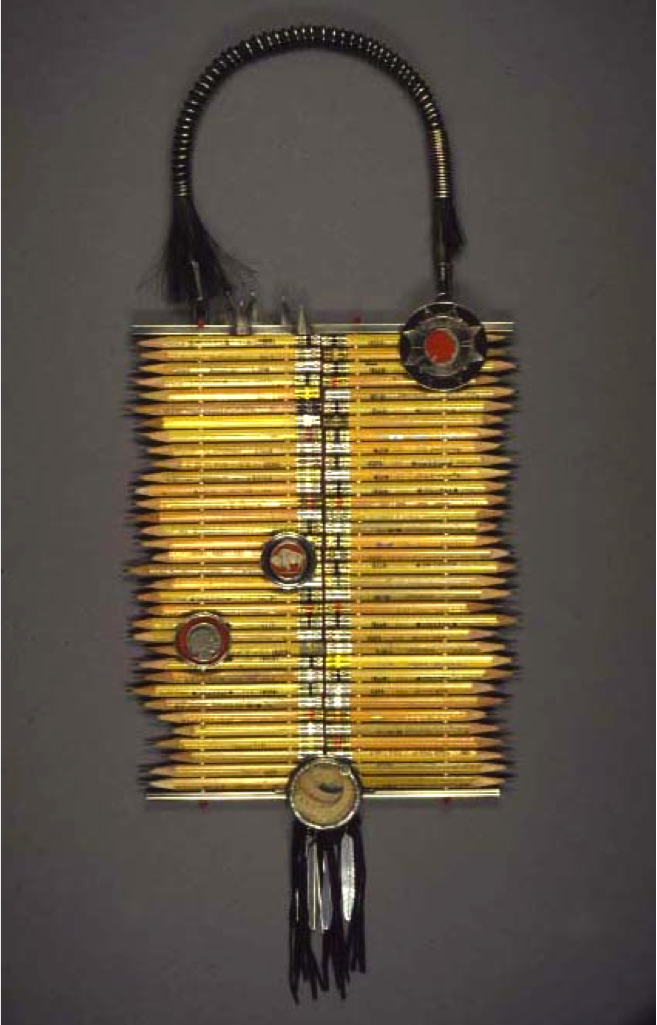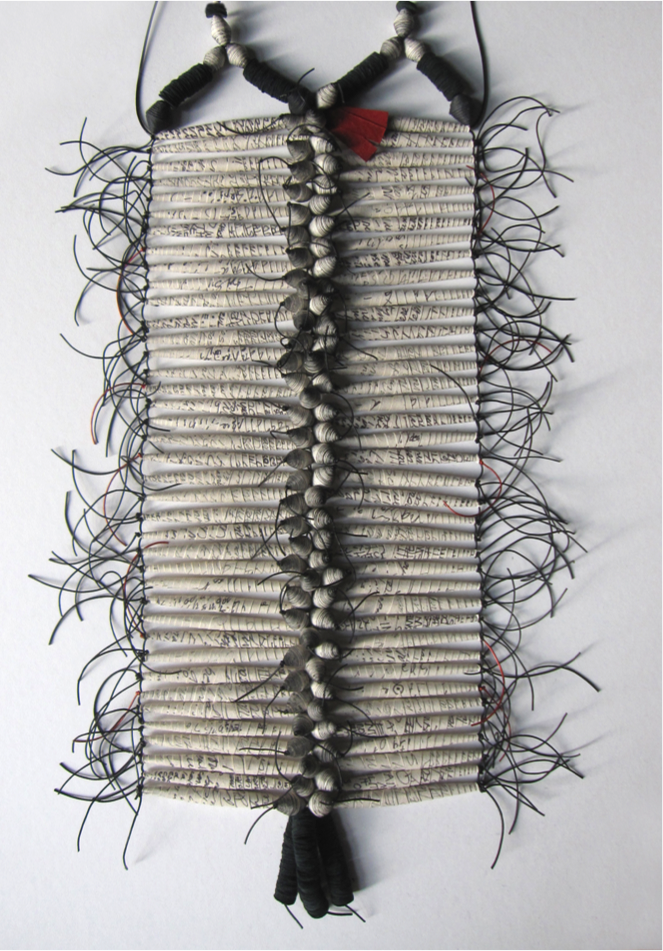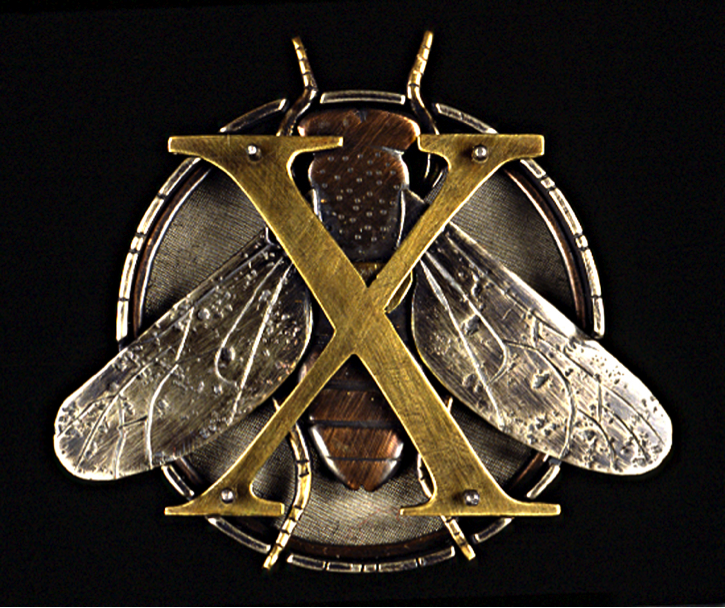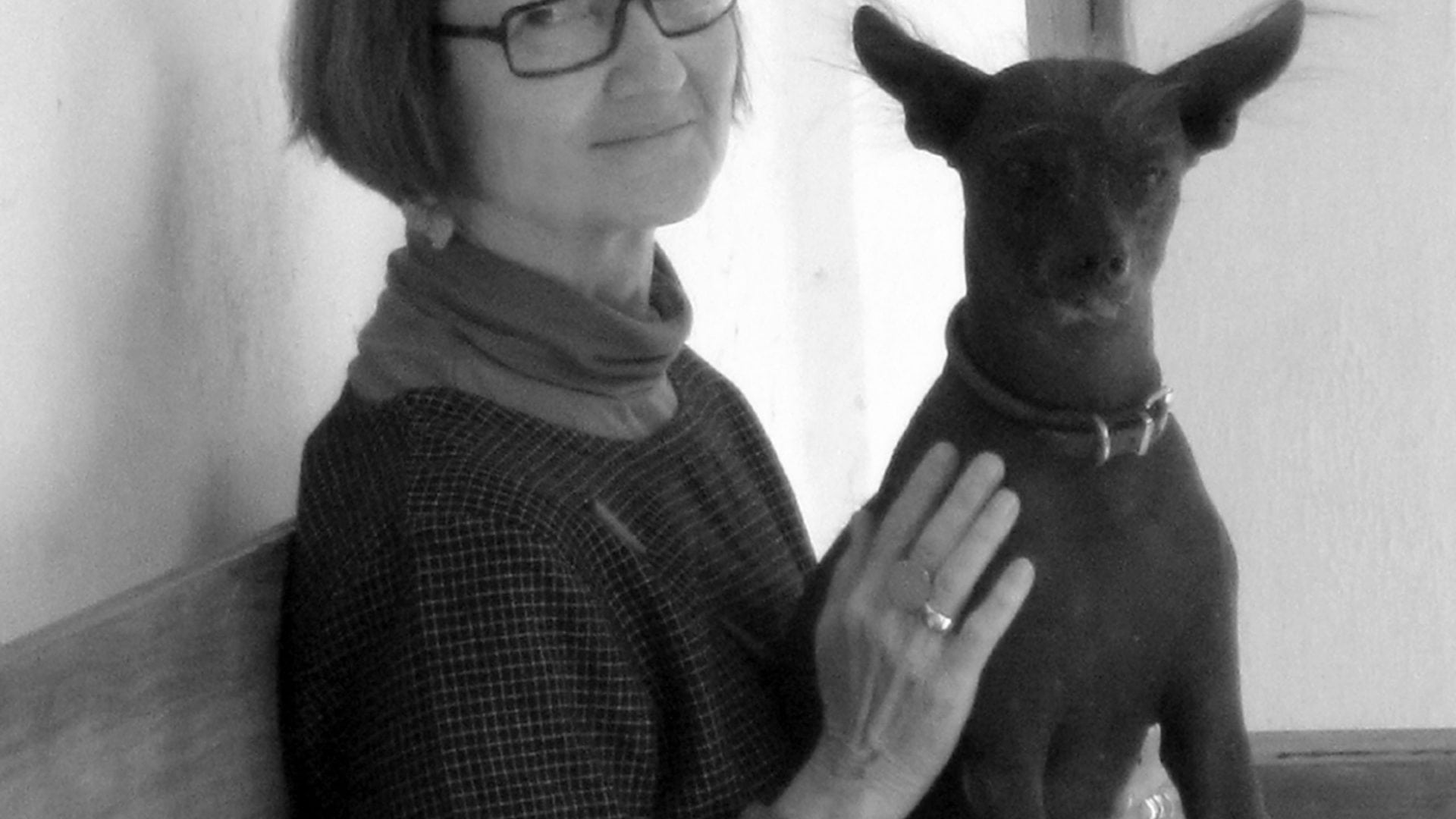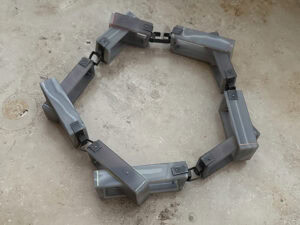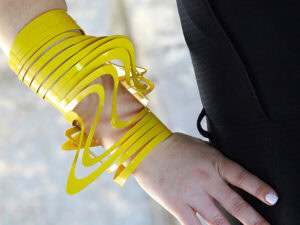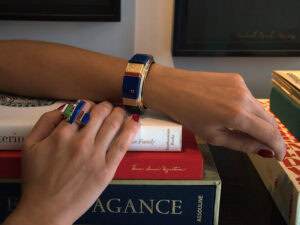After 35-years experience working as an artist, I realize in preparing this talk that I can now be an anthropologist—a cultural and material anthropologist of my world of work. I have the opportunity to examine it, analyze it, and give it some sense that might not have been apparent at the time of making. I often think there are two selves to me, as I’m sure many people do, particularly artists. One self always seems to be directing the other from a distance, or more accurately, from a depth of awareness the other self’s intentions don’t yet know. This is now quite clear when I look at how working in Mexico with handmade paper came about after many years of working with metal as an artist making jewelry.
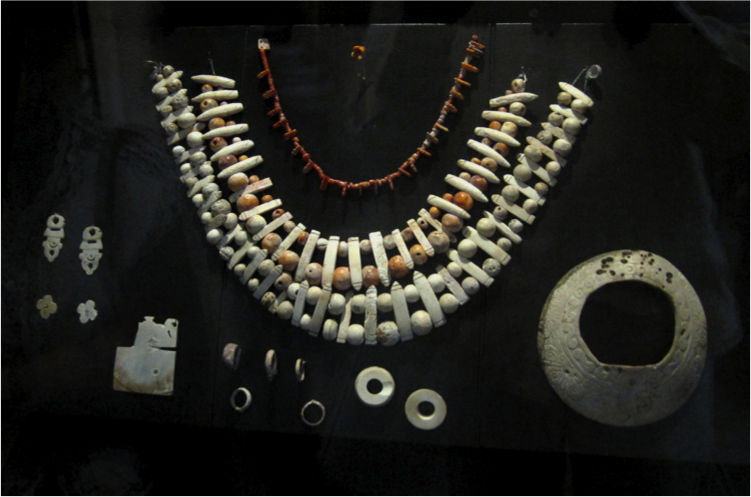 On a brief trip to Mexico in 1966, I saw the collection of jewelry from Tomb 7 found at Monte Alban, an ancient Zapotec site near the present city of Oaxaca. This collection of jewelry was diverse and layered and highly symbolic. It was both representational and abstract. Made from all kinds of material in addition to the more expected gold and silver, including shell, coral, amber, pearl, turquoise, jade, obsidian, and bone. Evidence of a culture. Not on the scale of pyramids, but powerful in its collective presence and in its suggestion of something larger than the scale of an individual piece. Though I didn’t know the specific layers of meaning in these pieces, they left an impression, including the threads that I can now see running consistently through my work: the idea of scale, the language of materials, their possibility for metaphor and the idea of array, exploring in fragments and variations, more than one to make one.
On a brief trip to Mexico in 1966, I saw the collection of jewelry from Tomb 7 found at Monte Alban, an ancient Zapotec site near the present city of Oaxaca. This collection of jewelry was diverse and layered and highly symbolic. It was both representational and abstract. Made from all kinds of material in addition to the more expected gold and silver, including shell, coral, amber, pearl, turquoise, jade, obsidian, and bone. Evidence of a culture. Not on the scale of pyramids, but powerful in its collective presence and in its suggestion of something larger than the scale of an individual piece. Though I didn’t know the specific layers of meaning in these pieces, they left an impression, including the threads that I can now see running consistently through my work: the idea of scale, the language of materials, their possibility for metaphor and the idea of array, exploring in fragments and variations, more than one to make one. As an artist working in the medium of jewelry, matters of scale are always of utmost consideration. I often work in series, where individual pieces expand into a conceptual whole. I like to use the strength of the diminutive to counter assumptions about jewelry, to add to ideas about art, and to contribute to the continuing worth of the physicality of ideas. Jewelry is not a usual site for art, though it often appears in museums as indicators and identifiers of past cultures. It is the unexpectedness of jewelry as art that has held my attention all these years.
 My early teachers were the anonymous jewelers from many cultures whose work is often patronizingly referred to as folk or ethnic art. This work, produced by non-industrial societies, is ingenious in design and engineering, radical by our standards in range of materials, and often highly symbolic, charged with meaning. In this jewelry, material value was often given metaphoric dimension in the organic synthesis of idea and form. In this work, content is expected to be socially or spiritually generated and the form a visual analog of the content.
My early teachers were the anonymous jewelers from many cultures whose work is often patronizingly referred to as folk or ethnic art. This work, produced by non-industrial societies, is ingenious in design and engineering, radical by our standards in range of materials, and often highly symbolic, charged with meaning. In this jewelry, material value was often given metaphoric dimension in the organic synthesis of idea and form. In this work, content is expected to be socially or spiritually generated and the form a visual analog of the content. The other important teacher for me has been the work itself. I soon learned, through working directly by hand, the value of limitations. Though intelligence and logic are excellent tools, the hand has its own dreams, too, its own hypotheses, as Gaston Bachelard has said. I’ve kept my technical practices quite simple in order to keep open to the vitality of an idea. Answers are so often static. Questions are not.
Alchemy is a narrative piece in that it depicts the process of turning base metals into gold. To the early alchemists, this process was a metaphor for turning the worldly self into a spiritual one. For me, it was a metaphor for the value of obstacles. It is also a collection of parts, apparatuses, and tools, that’s proliferation does not guarantee desired results. The actual gold in the piece is a drop at the end of one of the few pieces I’ve made containing gold. It was the idea of gold that interested me most rather than the gold itself.
My materials are not precious in the usual sense, often reused, and mined for their metaphoric possibilities. There is an element of rescue of the discarded, the beat up, and worn out. To give what’s already there a new space to occupy, a different context. A matter of celebration rather than lament.
I owe a great debt to jewelry from other cultures, both in the chosen material and in designs and forms capable of great drama and also of a kind of fierce subtlety.
Protection is part of a project commemorating historic body ornament that has influenced me through the years. Most of my pieces use look-a-like modern objects to refer to and comment on the original context. These are not always simple references, however. They are more like collaborations between me and the traditional artist, trying to understand more about one culture collecting and adopting the art of another, while perhaps participating in its disappearance. My breastplate is made of pencils rather than bones, referring to the lack of protection written treaties provided native peoples.
Here are two additional versions, one with black pencils and one in paper and ink. All these pieces contain references to writing. I’ve often thought I wanted to write, but ended up making jewelry as if it were writing, both in a narrative sense and a poetic sense.
In Electric Claws Bakelite knobs from all manner of electrical devices replace the claws and teeth used by many tribal cultures that appropriate an animal’s spirit and power by wearing its weapons. Appropriation in art is not new.
Much of my activity in jewelry has been open-ended exploration, evolving bodies of work rather than individual pieces intended as ends in themselves. I’ve veered away from the masterpiece idea and craft for its own sake. I often work in series, preferring to produce exhibitions of closely related work, partly to avoid the pitfall of style, but more importantly, to cultivate a wider examination of the central question I am trying to answer, exploring an idea from many angles. I rarely feel I’ve made a complete piece that isn’t merging into another or doubling back to a previous idea for a second or third look.
And from the beginning, there has been the need to connect, to communicate, to be part of the flow of ideas, part of a community. As the video and installation artist Gary Hill has said, “Art belongs by right to the ongoing conversation between friends of the work, intimate lovers of the work, its enemies, and all those whose world is informed and transformed by it.”
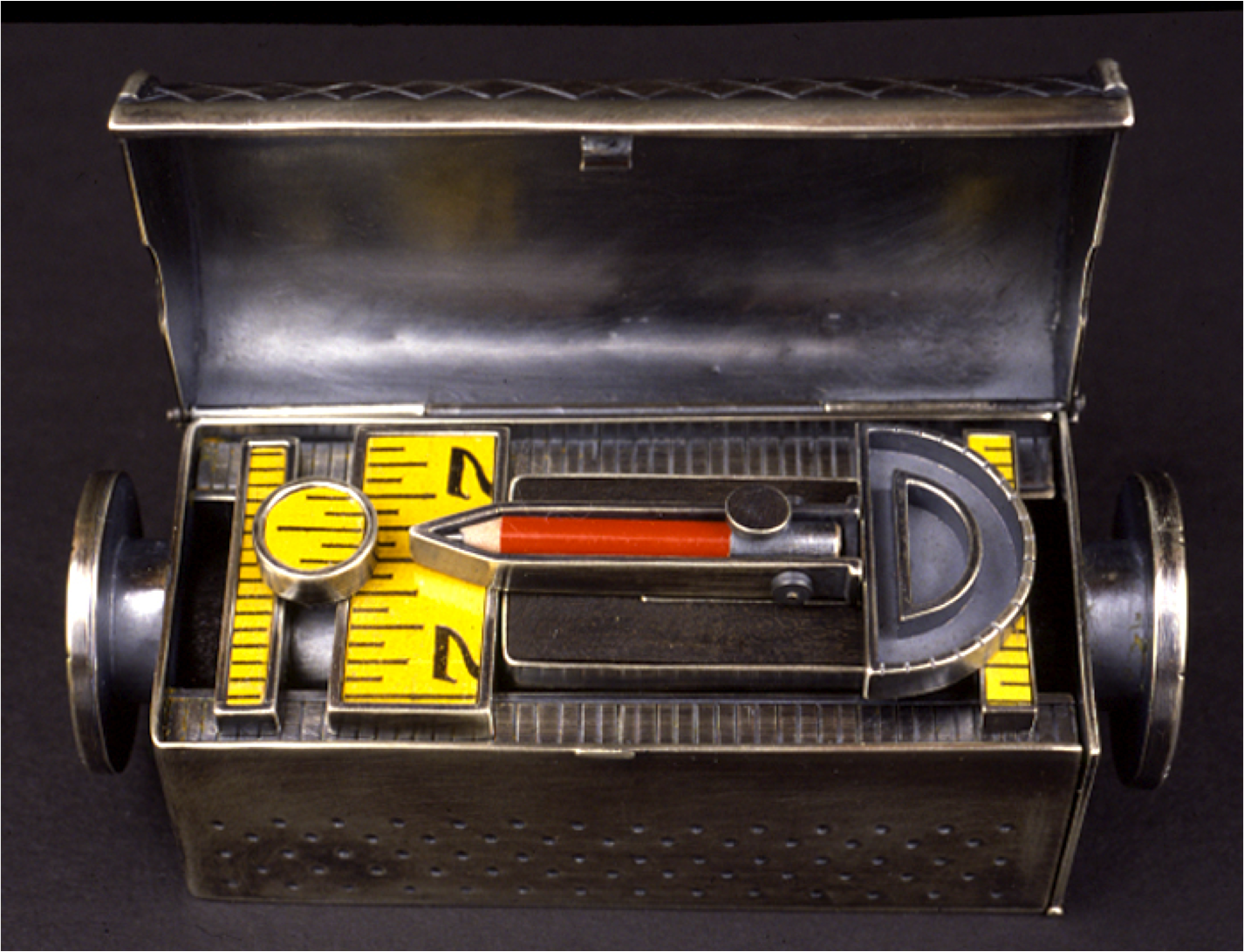 To quote Louise Bourgeois, “I am not what I am. I am what I do with my hands.” The hand as an image and as a metaphor is an abiding reference in my work. The distance of the hand held, reading distance so to speak, determines my sense of scale and proportion. The hand is the original measuring device. I realize, now, how long I have been trying to understand the importance of the hand as a form of experience, and by extension, as a form of knowledge. When using found or recycled material, I am often attracted to what can be held. I have considered how making by hand is increasingly an endangered species of experience and imagined tools that fit right on the hand—always there when you need them.
To quote Louise Bourgeois, “I am not what I am. I am what I do with my hands.” The hand as an image and as a metaphor is an abiding reference in my work. The distance of the hand held, reading distance so to speak, determines my sense of scale and proportion. The hand is the original measuring device. I realize, now, how long I have been trying to understand the importance of the hand as a form of experience, and by extension, as a form of knowledge. When using found or recycled material, I am often attracted to what can be held. I have considered how making by hand is increasingly an endangered species of experience and imagined tools that fit right on the hand—always there when you need them.For Hand Tools I constructed a set of tool rings, one for each finger. When not worn, these rings reside in a small, silver double-hinged box. In some humorously perverse way, I liked the box’s reference to the life of jewelry at rest, as opposed to the traditional notion of the jewelry box containing one’s valuables.
Here, the eight toolboxes were part of a sculpture exhibition—the smallest things in the show. One of my reasons for making them in the first place was to learn more about how scale is altered by context. In the oversized photographic enlargements of the rings on my hand that were hung next to the work, the rings are much larger than the tools they reference, and the hand becomes a landscape.

Changing context, juxtaposing seemingly disparate objects and material, and torqueing assumptions occupied the early Surrealists, and to them I owe another debt. It is possible to follow this thread throughout much of my work.
Here is Andre Breton, the father of surrealism, at home, sitting in front of a small collection of insects. The surrealists were intensely interested in exotic worlds and in questioning principles of classification and order. Joseph Cornell’s ordering of butterflies shifts the traditional scientific approach of classification and produces a kind of reverie.
The values of collecting and comparing are evident in collecting insects, whose scale offers up the possibilities of many specimens, many variations in species, and within species, in the individual. Collecting can be a form of knowledge through an enhancement of seeing. Think of Darwin and Wallace and their discoveries through collecting specimens to realize the processes of evolution.
In 1996, I completed 26 pins as a single piece called Insectopedia, where each letter stands for a specific insect. It was scale again and a more direct connection with image and language that led me to explore classification in this way. The alphabet is the ultimate of reduction, and insects are the ultimate of proliferation.
As a kid, I spent a lot of time in my father’s printing plant, where he published a weekly paper. I loved working there—the smell of the ink, the drama of the old hand-fed press, and the linotype machine that turned hot metal into words, something I’m still trying to do today. Those words, and the letters that made them, had a physical as well as poetic presence for me. It is just a slip of the tongue, and a common printer’s mistake, from etymology (the study of words) to entomology (the study of bugs).
In making insects, I liked the idea that, for once in the act of representing, I could make something bigger than it actually was. And it was not only the intricate structure and scale that interested me, but also the atmosphere of insects, their otherness, their powers of suggestion, their numerical superiority, their bite.
A poem by Joseph Brodsky called “The Butterfly” was particularly close during this time.
It seems to me you are
A protean creature,
Whose markings mask a feature
Of face, or stone, or star.
Who was the jeweler,
brow uncontracted
Who from our world extracted
your miniature—
A world where madness brings
us low, and lower,
Where we are things, while you are
the thought of things?

Jewelry is associated with preciousness. But, photographs can be more precious than just about anything—people will grab family albums before their jewelry when forced to flee their burning homes. But how to cut into these images, to interrupt their passage through several generations? When I realized that their preciousness depended on their identity, and that this identity had already been lost, abandoned, the possibility for a new presence eased my reluctance, and I began to look at the hands, to see what they said. Very soon, I saw how they connected to the previous series of toolboxes. I added to that series a set of five rings called Self Storage. Each ring contains a photograph of a hand protected by mica, which is also used in the lid of the box. Within the see-through box, the hands become like specimens or like objects in a reliquary.
As I continued to look at the hands, the photographs became the source of a kind of meditation on photography and ended up in an exhibition called Cuts and Repose. Hands again in Pose and Brothers.
 Here, the hand shows up in the pitcher along with other body parts. In seventeenth-century Dutch painting, the still life was often associated with a certain pathos. The surrealists wanted to break down the so-called effect of the real, through juxtaposition and collage. In the necklace called Still Life, the photographs showed me there was still life in them.
Here, the hand shows up in the pitcher along with other body parts. In seventeenth-century Dutch painting, the still life was often associated with a certain pathos. The surrealists wanted to break down the so-called effect of the real, through juxtaposition and collage. In the necklace called Still Life, the photographs showed me there was still life in them.Another reference to the past in photography is from the multiple image studies of Eadward Muybridge. I used the image of my hand counting in the bracelet called Countdown.
Muybridge’s major photographic exploration was called Animal Locomotion. In my Manual Locomotion, each gesturing gloved hand is a separate wheeled pull toy that actually pulls. Hooked together and upside down, they become a necklace.
I tried to condense images as far as possible while still keeping them recognizable. The two versions of the bracelet Wrist Flick, with their slivers of images, suggest a kind of film-noir narrative. Here, the more abstract images, such as a fraction of wavy hair, are identifiable by their proximity to more obvious representational features, such as eyes.
 The repetition of mouths in Wall of Silence makes for a kind of abstraction that is, again, a connection to surrealism. In Perfect Attendance, there is a tension between the abstraction through repetition, and the rather unsettling representation through the top image of the child’s forehead. The form of the pin, like attendance pins from the 1950s, sets up a play on words with the eyes every attending.
The repetition of mouths in Wall of Silence makes for a kind of abstraction that is, again, a connection to surrealism. In Perfect Attendance, there is a tension between the abstraction through repetition, and the rather unsettling representation through the top image of the child’s forehead. The form of the pin, like attendance pins from the 1950s, sets up a play on words with the eyes every attending.Many early-twentieth-century avant-garde artists used abstraction in an attempt to create original forms that could have a common meaning for all viewers. Communication of nonvisual information in visual forms represents a major area of investigation for us as contemporary artists. This is probably what has driven me more than anything to continue working as an artist in jewelry.
Some of the photographs were particularly difficult to cut, and in the case of Toy, I sawed into the image and extracted only one part, leaving the rest of the image intact. My unease in cutting mirrored an unease in the photograph itself and a kind of shift in scale with the dislocation of the fragment.
Dislocation and a kind of tension in the use of material were most magnified in the exhibition called Re:Pair and Imperfection. Here, the idea was to examine perfection as a criterion for craft, of originality as the measure of authenticity, and of re-use and the value of repair. I asked 18 artists whose work I admired to contribute an abandoned, damaged, or incomplete piece of theirs for my reworking and/or “repair.” I tried to complete the piece as part of my inquiry into a deeper understanding of the value of imperfection.
Imperfection can provide openness, a way in, whereas perfection is often closed and frozen in place. Imperfection can contain energy, can make for flow. Yet, so often craft is defined by perfection. Examining imperfection led to its clear-cut manifestation—repair—and what it might indicate in contemporary culture. There were many layers to this project, raising many questions. Where does the original maker’s work end and mine begin? How do I maintain the integrity of the original? How much do I refer to what I know of the intentions of the artist? In terms of repair, what is broken, what needs fixing? Is this collaboration or something else?
 Strangely enough, I can extend these ideas into a connection with Marcel Duchamp’s concept of art. He felt that art is not art until the artist, the work, and the viewer have all connected. And sometimes, I think imperfection can precipitate this connection. (Duchamp felt his Large Glass even better after it was accidentally broken.)
Strangely enough, I can extend these ideas into a connection with Marcel Duchamp’s concept of art. He felt that art is not art until the artist, the work, and the viewer have all connected. And sometimes, I think imperfection can precipitate this connection. (Duchamp felt his Large Glass even better after it was accidentally broken.)In trying to understand flaws, I looked at the physical and philosophical aspects of repair. I remembered how in Japanese culture when revered tea bowls are broken they are put back together. Rather than hiding the repair, the crack is filled with gold leaf, a sign of the history of the bowl rather than any compromise in aesthetic integrity. Perhaps only in Japan could a plain white, eighteenth-century Delft plate be repaired by an early- twentieth-century craftsman by carefully carving the missing piece out of wood.
A repaired object can be charged with so much other than its perfect self. It reveals human intervention—the intervention of the hand as well as ingenuity of thought, like the little West African lamp.
I want to show a few examples from the exhibition Re:Pair and Imperfection, where 33 pieces were shown in handmade boxes along with a framed photograph of the fragment that instigated each piece. Here, there were many parts to the whole, where the exhibition became the piece, approachable from many angles and layered—a kind of geology of presence.
For Otto Künzli, the idea behind the work is inextricably connected to its appearance. His rubber bracelet called Gold Makes You Blind is, to me, a nearly perfect piece of jewelry. Inside the rubber tube is a gold sphere. Jewelry’s value is so often determined in our culture by the value of the materials, but here the gold is invisible. And the simple rubber bangle is beautiful, too, in a stark and tactile way. After long time wear, the rubber wears away, exposing the gold. “Like an eye,” as Otto described in his letter. He is adamant that the gold remain hidden and therefore agreed to replace the bracelet when this happens. The small, partially crushed sphere he gave me was damaged as he pushed it into the rubber tube, rendering it useless in the new bracelet. As I read Otto’s letter, a poem called “The Panther” by Rainer Marie Rilke came to mind. I decided to refer to this poem directly by making a tiny cart of silver and rubber. The cart was eye-shaped from above, and the undamaged side of the gold sphere became the pupil of the eye extending up out of the cage. This poem is shown in the box with the piece.
Thomas Gentille is a master of the minimal in contemporary jewelry. His pin on the left is intricately inlaid with eggshell. I had long discussed my ideas of imperfection with Thomas. I remember remarking that since he aimed for such perfection in his work, he may not connect with what I valued in imperfection. He answered, “Oh I know just what you are getting at—I’m still trying to make the right mistake.”
The piece that Thomas sent was a chipped circular form of synthetic resin. In the spirit of Thomas, my approach to this piece was almost entirely formal, which is not a usual resolution for me. However, soon after finishing the resin piece, another package arrived from Thomas.
He had just found the chip from the first resin piece and thought I might want to use it in the repair. However, I liked the little package itself, with his writing, sealed with Scotch tape, so I left it unopened, with a connection to the Otto Künzli bracelet. It became a kind of mascot for the whole project, occupying different spots on my table for over a year. I finally decided to treat the package as a precious relic, housed on the hand in a two-finger ring.
The reliquary idea shows up in my approach to a piece from Keith Lewis. Keith speaks very directly about jewelry’s capacity to be subversive and proves it in his work. His adherence to ideas, often sexual and confrontational, take form in aesthetically exciting ways. It’s important to remember that an idea has to be as good as it looks when it comes to making. Keith’s necklace 34 Dead Souls, made to honor friends lost to AIDS, is a most powerful piece of contemporary jewelry as art.
One time, Keith showed me a tiny carved-wax wolf head he thought of using in a necklace that celebrated the brothels of Pompeii, known as the Lupanar. After deciding not to use it, he gave it to me since I had admired it. Much later, I asked if I could use it for this project. My plan to make a reliquary for it was reinforced after a trip with Keith to visit Pompeii. The form for the reliquary was obvious, and I liked that this little wolf head was monumentalized in this way. The writing on the box lid was one of many lines of graffiti scratched on the walls of the Lupanar. Viinimus is Latin for “We Came.” Some years before, I had made a necklace from a Simon Bolivar cigar box called By Hand.
There is a broad range to Daniel Jocz’s work, from the narrative to the abstract. This adventurousness leads to a greater understanding of how images work, so that a piece such as American Requiem, a series of six pins made after 9/11, can have real impact without exploiting built-in emotional charges.
When Daniel wrote that he was sending cast silver lettuce leaves, I thought they might be a possibility for an unrealized idea of a few years before involving a news story I heard on the radio. When the fragments arrived, they were less leaf-like than I imagined, but still I wanted to try. I got some AK-47 shells thanks to a Vietnam veteran friend and cut them to fit on the leaves. For this piece, it seemed important to include the story on the inside lid of the box.
One day during the war in Bosnia, a report on the radio ended with an arresting image. A resident of a village that had come under attack the night before answered a journalist’s question by saying, “This morning when I looked out the window at my garden, I knew the fighting was now very close. There were bullet casings on the lettuce leaves.”
Lisa Gralnick’s project called the Gold Standard involves another take on narrative. She sees it as “conducting an inquiry into the value systems through which contemporary society negotiates progress, accumulates knowledge, and promotes physical comfort through consumerism.” And as she says, “Gold, as an infinitely recyclable material, embodies both the potential for the noblest testaments to the history of civilization and the disturbing ability to erase that same history” by being melted down and recycled. She made plaster casts of many familiar objects and included one detail in enough solid gold to represent the value of the object.
One Gold Standard piece involved plaster casts of Lisa’s hands, one of them holding a gold cigarette. The gold in the cigarette corresponded to the value of a year’s worth of cigarettes for Lisa. As we were standing in her studio looking over the casts, I remarked that if there was ever a finger that got broken off, I’d be interested in having it. Without hesitation, Lisa reached over and broke off the index finger from the cast of her right hand. This was immediate service! This finger also had the power of a Medieval relic, a piece of someone revered. The finger can be worn as a pendant on a chain, but while at rest, it is strung up on the crane. As a lover of puns, I liked the implications of Lifting a Finger—taking the trouble to do something that might make it important. What artists do. And maybe, what comes out of the Re:Pair project is once again how the act of making by hand matters. How can we protect this endangered form of experience? How can we renew our respect?
In the piece by Rachelle Thiewes on the left, I used two of her silver thorn forms to complete a necklace I had previously designed for a paper project in Mexico, where I have been working over the past 12 years, contributing designs for jewelry made of paper.
An abandoned early twentieth-century hydroelectric plant in San Agustin Etla near the city of Oaxaca became the site for a papermaking facility in 1998. Its founding was thanks to the efforts of painter, printmaker, and cultural activist Francisco Toledo.
The workshop serves to revive papermaking, abundant in pre-Columbian culture, and to provide work for local people. Water, which was crucial to the project, is a dependable local resource as are the renewable fibers of plants grown in the area. A pulping machine was donated by the Art Paper Center of Finland, along with the services of a technician for initial training of the workers. Artists invited by Toledo worked with the artisans to create traditional and innovative uses for the handmade paper.
The technology for making the paper is contemporary, familiar to papermakers around the world. The fibers, however, are derived from trees, shrubs, and plants growing in the region of Oaxaca, such as majahua, chichicastle, agave, and pochote. Some of these fibers are from the bark of fast-growing shrubs and others, such as pochote, are from a yearly harvest of pods from trees. A native, pale brown cotton, coyuche, is used as well as industrial cotton, originally from a large textile mill nearby, which has now become an art school and cultural center (CASA).
The elemental nature of paper made from these fibers and sized with the juice of the nopal cactus make it strong and durable. Coloring dyes are derived from indigo, cochineal, ochre, and other local vegetable and mineral sources in addition to aniline dyes.
The workshop has evolved since its founding and is now a cooperative currently made up of 13 people making paper, books, kites, boxes, and jewelry along with specific commissions for individual designers and artists. Unlike other traditional craft in the culturally rich area of Oaxaca, papermaking began fresh in Vista Hermosa in 1999. However, the making of paper and the making of books was a vital part of pre-Columbian cultures, and the destruction of thousands of indigenous books soon after colonization has served to further emphasize the significance of paper and books in current culture. It is this importance of paper and books and their making by hand that drew me to working with paper as a material in jewelry.
In 2000, I was invited by Francisco Toledo to work in the paper workshop. I respected and admired Toledo’s efforts to revive past technologies and to provide work for the local people. He thought I might have something to offer through my knowledge of jewelry. However, I worked with metal, not paper. But, I like what happens when obstacles present themselves and staying open to the infusion of new energy through such shifts in material—and circumstance. After considerable pause, I agreed to try designing jewelry and paper for particular purposes that the young women who worked there could learn to fabricate and reproduce.
I was not at all used to thinking in production terms, as most of my designs were more one-of-a-kind pieces. However, I quickly widened my ideas of how the paper might be used in different forms—as pulp, wet, dry, cut, and folded.
That the paper was made from fibers grown in the area was particularly important. It was interesting to reflect back to ethnic jewelry, its identity with indigenous materials, and at the same time, the immediate synthesis of outside materials when they fit cultural and aesthetic needs.
When we began, most of the young women were in their teens. I was starting at the beginning of making jewelry out of paper, and so were they. I was, however, used to thinking of jewelry outside the traditional notions of materials, and they were not. But they were curious and attentive and accepted my role as teacher.
The initial designs were very simple. I would make the piece first, and they would record the steps to its construction. We learned how much could be made with simple technology—when paper is cut, folded, inked, and wrapped.
We worked very hard that first month and ended up having a small exhibition at the Institute of Graphic Arts in Oaxaca, alerting the community to the activity of the workshop. And there was keen interest from the get-go, which gave everyone confidence in the value of the endeavor. I wanted to see the workshop occupy a place in both the local and wider arts community. And I wanted to continue in that community, too, and widen my own. I became more involved in figuring out designs that would be simple and fresh and might find a market in Mexico.
No formal plan was made to continue. However, it turned out I kept returning to Oaxaca year after year, supposedly for time off, but really for work at the workshop. I became a teacher of design, not considering it a part of my work (though of course, everything is), but rather with an eye toward solid production that would provide income for the workshop, which it did.
I have contributed my designs to Arte Papel, and these are some of the pieces that are most often made. The original designs began with a few basic forms. The elements have now been repeated, recombined, enlarged, reduced, and recontextualized in myriad variations.
I doubt that I would have done such work were it not for the particular circumstances that presented themselves. The women and I have a strong working relationship built on trust, mutual respect, and the true pleasure and pride in the making of beautiful and unusual jewelry. The project has evolved over the years, with complicated and nuanced layers of working together in a complex collaboration that contradicts assumptions of culture and authenticity and invigorates cross pollination.
After working for two- and three-week stints over the years, we had something to say about paper as a resource for jewelry: its capacity for simplicity and elaboration; for structure and design; and also for countering assumptions about durability. Through paper, the possibility of materials as metaphor for ideas in jewelry was expanded. The spirit of invention in unusual circumstances with limited but focused resources would not have happened without the combined effort and skills of all of us. More than one to make one.
With an idea toward an exhibition in Chicago, I started to think as an artist about how we could reaffirm the use of paper in contemporary jewelry (and of jewelry in art) as well as connect to the cultural past of paper in Mexico. The physicality, the essence, of the paper was more present, and there was an edge to its context as jewelry to be worn and handled. We began to work in reverse, making all of the basic designs and elements in white paper. The finished pieces in white became more abstract, their structure as well as their reference to the past more evident. We came to see them as bones.
I began this talk with the three threads of scale, the language of material, and the idea of more than one to make one. These three coalesced once again in the exhibition called Pride of Paper at the Chicago Cultural Center.
For the exhibition, we kept an extra drawing for the patterns to show on the wall next to the white pieces, not only to show the patterns as drawings, but also to give a sense of transformation from flat sheet to dimensional jewelry. And to demonstrate the different texture and weight of the sheets.
In contrast, the colors became more like skin, piel[2]. And then we learned how the same form, the same bracelet or necklace, took on a different character depending on the color. This combination of substance and surface continues to offer up fresh perspective when considering jewelry and paper. For the exhibition in 2010, one gallery was all white, and the adjoining larger gallery was all color. The columns of paper on the wall show how many sheets of paper make up the necklace on the shelf below.
The exhibition was not unlike the approach I have taken for many years, where individual pieces are parts of a larger idea rather than complete on their own. More than one to make one. It is the experience of the exhibition rather than the experience of a single piece that holds my attention as an artist. An installation allows the individual parts to come together to make something beyond their singular identities. It is this kind of layering of visual language that is, perhaps, harder to expect from one piece and that may be more akin to poetry than product.
The white pieces were, from the beginning, the art part of my work with Arte Papel. They were shown in an exhibition in Oaxaca at the Institute of Graphic Arts, at Gallery Loupe in New Jersey, and at the Douglas Dawson Gallery here in Chicago. For some time, I have been working on a book that further contextualizes the white pieces as well as serving as a document of the project. The book became an alternate form of exhibition, and honors books and paper, the spirit of both—right where we started.
Making jewelry out of paper is not the same as metal, yet paper, contrary to what people may think, is strong. There is fragility in one sense and strength in the other. The white pieces are wearable, but they need particular care. Some of the white pieces became more like drawings or like architecture when off the body. I don’t always think of the body as the site for jewelry in the literal, wearable sense, but I like to think of the idea of wearing, the implied site of the body. And I also like the idea of wearing an idea. In the case of the white pieces, there might be unease in their usefulness as jewelry. And I like that tension. Sometimes, it is important to counter assumptions, to work with the tension and release of such an encounter. Jewelry is not often expected to be art, but its context can alter expectations, and I would hope to do that now and then.
Here, you can see the possibilities of the necklace 8 Squares and 1 Rectangle. What happens to its reconfiguration on the body. And in this instance, one piece has the possibility of being more than one. And another example in Fence.
I like to think that paper is the site of poetry, of drawing, and in the case of jewelry, the unexpected site of both. Poetry takes me back to language, the language of materials, to the vocabulary of my work and my recurring tendencies toward the array—more than one to make one.
Throughout the work in paper, I continued in metal (including another exhibition in Chicago and one in San Francisco), though at one point a few years ago, I wondered about the longevity of both. I made, at that time, a necklace called A Reliquary of My Own Making. It’s a play on words as the necklace depicts in photographs the process of its making. It’s a reliquary I made and a reliquary for a form of making. It was as though, in suggesting demise, I was actually reaffirming the necessity of its survival. Which takes me back to the beginning and the suggestion of double selves. Which leads me to paraphrase T. S. Eliot, who talked about ceaseless exploring, returning to the place we started, and knowing it for the first time. Metal continues to assert itself, and maybe the words on the fragment of my first polishing cloth enclosed in the back frame of the necklace speak for me also—“Good until worn out.” Let’s see.

